Financial Accounting Report: Analysis of Barclays Financial Statements
VerifiedAdded on 2023/02/02
|12
|3345
|87
Report
AI Summary
This financial accounting report begins with an introduction to financial accounting, defining its purpose and importance for both internal and external stakeholders, using Barclays as a case study. Part A presents a business report analyzing Barclays' financial accounting practices, including the roles of employees, management, vendors, financial institutions, customers, and investors. Part B delves into practical applications, covering double-entry bookkeeping, trial balance preparation, and the creation of final accounts like the balance sheet and income statement. The report also addresses depreciation methods and the application of bank reconciliation statements. The report includes practical examples, such as trial balances and profit and loss statements, and explores the reconciliation process, including the analysis of potential discrepancies between bank statements and company records, like errors, omissions, and bank charges. Finally, the report explores the process of reconciling control accounts and clearing suspense accounts and concludes with a discussion of different types of accounts, and the preparation of accurate reconciled accounts.
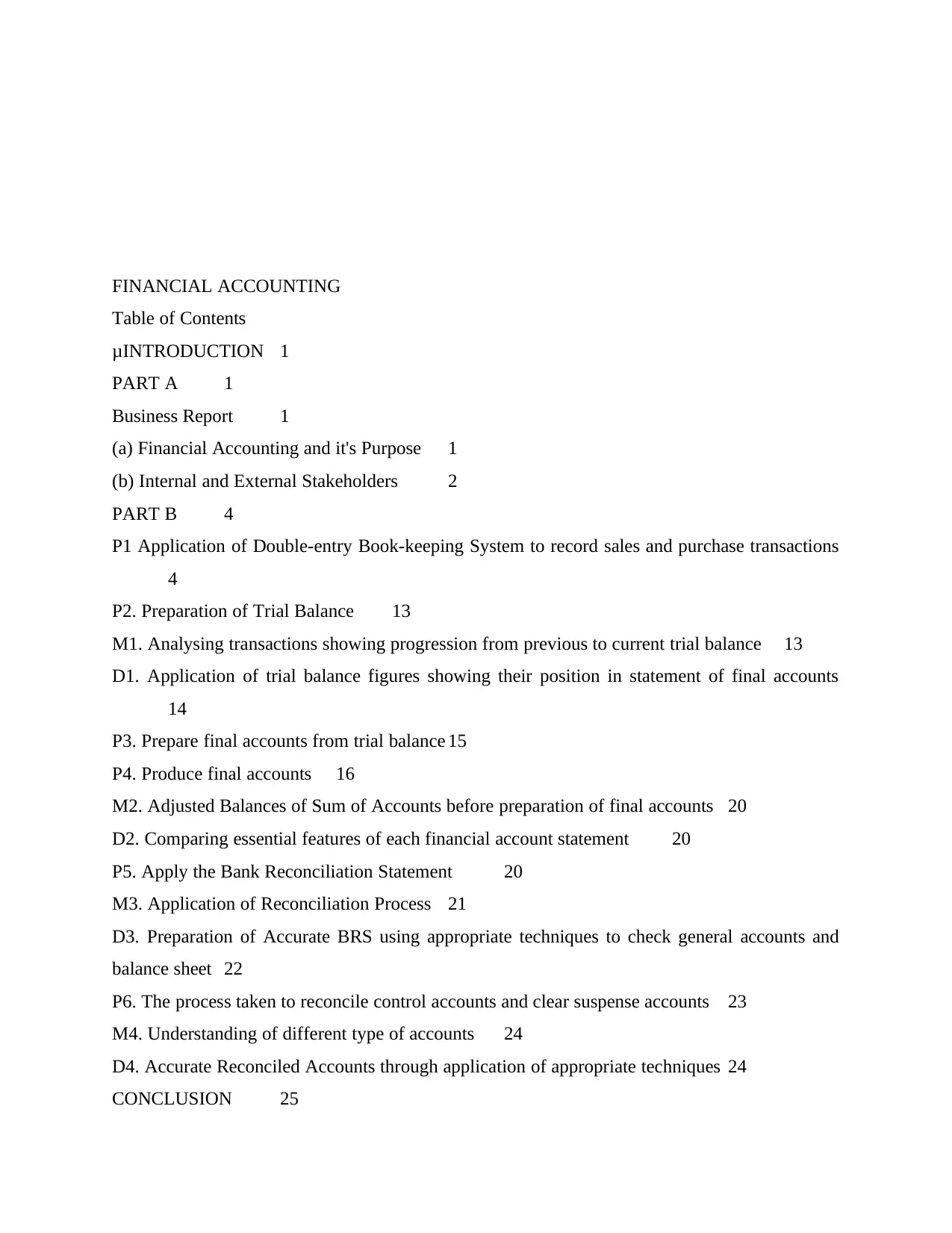
FINANCIAL ACCOUNTING
Table of Contents
μINTRODUCTION 1
PART A 1
Business Report 1
(a) Financial Accounting and it's Purpose 1
(b) Internal and External Stakeholders 2
PART B 4
P1 Application of Double-entry Book-keeping System to record sales and purchase transactions
4
P2. Preparation of Trial Balance 13
M1. Analysing transactions showing progression from previous to current trial balance 13
D1. Application of trial balance figures showing their position in statement of final accounts
14
P3. Prepare final accounts from trial balance 15
P4. Produce final accounts 16
M2. Adjusted Balances of Sum of Accounts before preparation of final accounts 20
D2. Comparing essential features of each financial account statement 20
P5. Apply the Bank Reconciliation Statement 20
M3. Application of Reconciliation Process 21
D3. Preparation of Accurate BRS using appropriate techniques to check general accounts and
balance sheet 22
P6. The process taken to reconcile control accounts and clear suspense accounts 23
M4. Understanding of different type of accounts 24
D4. Accurate Reconciled Accounts through application of appropriate techniques 24
CONCLUSION 25
Table of Contents
μINTRODUCTION 1
PART A 1
Business Report 1
(a) Financial Accounting and it's Purpose 1
(b) Internal and External Stakeholders 2
PART B 4
P1 Application of Double-entry Book-keeping System to record sales and purchase transactions
4
P2. Preparation of Trial Balance 13
M1. Analysing transactions showing progression from previous to current trial balance 13
D1. Application of trial balance figures showing their position in statement of final accounts
14
P3. Prepare final accounts from trial balance 15
P4. Produce final accounts 16
M2. Adjusted Balances of Sum of Accounts before preparation of final accounts 20
D2. Comparing essential features of each financial account statement 20
P5. Apply the Bank Reconciliation Statement 20
M3. Application of Reconciliation Process 21
D3. Preparation of Accurate BRS using appropriate techniques to check general accounts and
balance sheet 22
P6. The process taken to reconcile control accounts and clear suspense accounts 23
M4. Understanding of different type of accounts 24
D4. Accurate Reconciled Accounts through application of appropriate techniques 24
CONCLUSION 25
Paraphrase This Document
Need a fresh take? Get an instant paraphrase of this document with our AI Paraphraser

REFERENCES 26
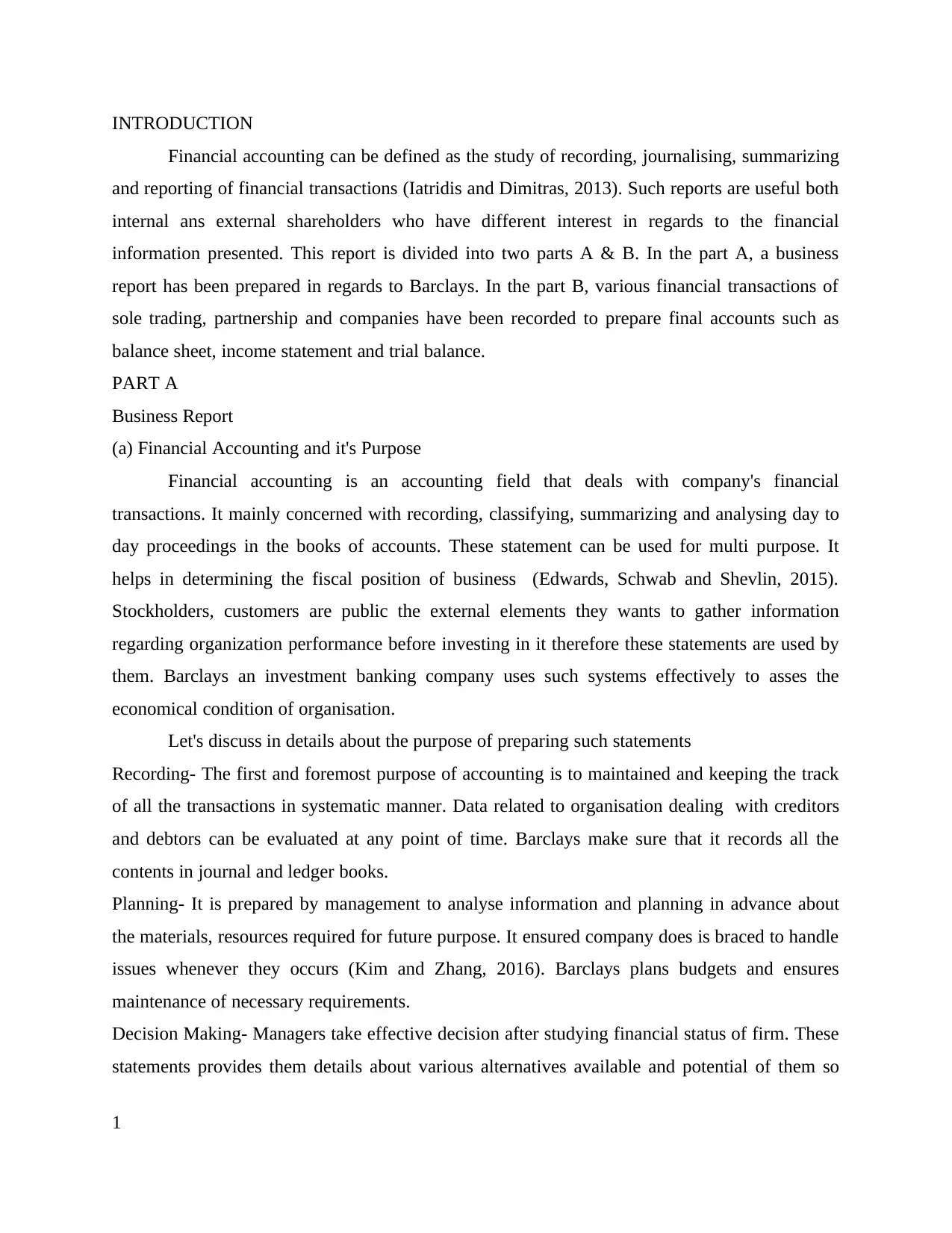
INTRODUCTION
Financial accounting can be defined as the study of recording, journalising, summarizing
and reporting of financial transactions (Iatridis and Dimitras, 2013). Such reports are useful both
internal ans external shareholders who have different interest in regards to the financial
information presented. This report is divided into two parts A & B. In the part A, a business
report has been prepared in regards to Barclays. In the part B, various financial transactions of
sole trading, partnership and companies have been recorded to prepare final accounts such as
balance sheet, income statement and trial balance.
PART A
Business Report
(a) Financial Accounting and it's Purpose
Financial accounting is an accounting field that deals with company's financial
transactions. It mainly concerned with recording, classifying, summarizing and analysing day to
day proceedings in the books of accounts. These statement can be used for multi purpose. It
helps in determining the fiscal position of business (Edwards, Schwab and Shevlin, 2015).
Stockholders, customers are public the external elements they wants to gather information
regarding organization performance before investing in it therefore these statements are used by
them. Barclays an investment banking company uses such systems effectively to asses the
economical condition of organisation.
Let's discuss in details about the purpose of preparing such statements
Recording- The first and foremost purpose of accounting is to maintained and keeping the track
of all the transactions in systematic manner. Data related to organisation dealing with creditors
and debtors can be evaluated at any point of time. Barclays make sure that it records all the
contents in journal and ledger books.
Planning- It is prepared by management to analyse information and planning in advance about
the materials, resources required for future purpose. It ensured company does is braced to handle
issues whenever they occurs (Kim and Zhang, 2016). Barclays plans budgets and ensures
maintenance of necessary requirements.
Decision Making- Managers take effective decision after studying financial status of firm. These
statements provides them details about various alternatives available and potential of them so
1
Financial accounting can be defined as the study of recording, journalising, summarizing
and reporting of financial transactions (Iatridis and Dimitras, 2013). Such reports are useful both
internal ans external shareholders who have different interest in regards to the financial
information presented. This report is divided into two parts A & B. In the part A, a business
report has been prepared in regards to Barclays. In the part B, various financial transactions of
sole trading, partnership and companies have been recorded to prepare final accounts such as
balance sheet, income statement and trial balance.
PART A
Business Report
(a) Financial Accounting and it's Purpose
Financial accounting is an accounting field that deals with company's financial
transactions. It mainly concerned with recording, classifying, summarizing and analysing day to
day proceedings in the books of accounts. These statement can be used for multi purpose. It
helps in determining the fiscal position of business (Edwards, Schwab and Shevlin, 2015).
Stockholders, customers are public the external elements they wants to gather information
regarding organization performance before investing in it therefore these statements are used by
them. Barclays an investment banking company uses such systems effectively to asses the
economical condition of organisation.
Let's discuss in details about the purpose of preparing such statements
Recording- The first and foremost purpose of accounting is to maintained and keeping the track
of all the transactions in systematic manner. Data related to organisation dealing with creditors
and debtors can be evaluated at any point of time. Barclays make sure that it records all the
contents in journal and ledger books.
Planning- It is prepared by management to analyse information and planning in advance about
the materials, resources required for future purpose. It ensured company does is braced to handle
issues whenever they occurs (Kim and Zhang, 2016). Barclays plans budgets and ensures
maintenance of necessary requirements.
Decision Making- Managers take effective decision after studying financial status of firm. These
statements provides them details about various alternatives available and potential of them so
1
⊘ This is a preview!⊘
Do you want full access?
Subscribe today to unlock all pages.

Trusted by 1+ million students worldwide
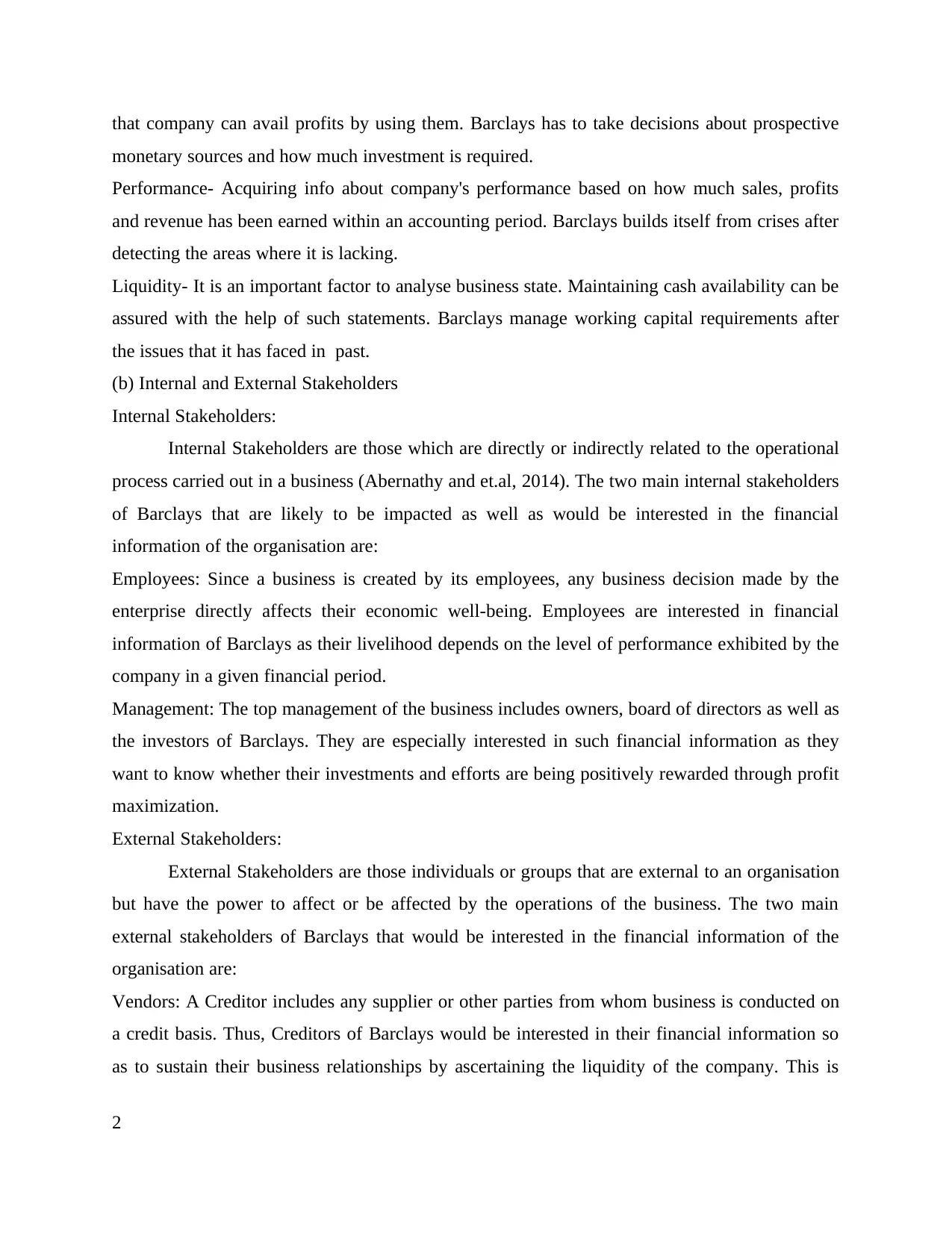
that company can avail profits by using them. Barclays has to take decisions about prospective
monetary sources and how much investment is required.
Performance- Acquiring info about company's performance based on how much sales, profits
and revenue has been earned within an accounting period. Barclays builds itself from crises after
detecting the areas where it is lacking.
Liquidity- It is an important factor to analyse business state. Maintaining cash availability can be
assured with the help of such statements. Barclays manage working capital requirements after
the issues that it has faced in past.
(b) Internal and External Stakeholders
Internal Stakeholders:
Internal Stakeholders are those which are directly or indirectly related to the operational
process carried out in a business (Abernathy and et.al, 2014). The two main internal stakeholders
of Barclays that are likely to be impacted as well as would be interested in the financial
information of the organisation are:
Employees: Since a business is created by its employees, any business decision made by the
enterprise directly affects their economic well-being. Employees are interested in financial
information of Barclays as their livelihood depends on the level of performance exhibited by the
company in a given financial period.
Management: The top management of the business includes owners, board of directors as well as
the investors of Barclays. They are especially interested in such financial information as they
want to know whether their investments and efforts are being positively rewarded through profit
maximization.
External Stakeholders:
External Stakeholders are those individuals or groups that are external to an organisation
but have the power to affect or be affected by the operations of the business. The two main
external stakeholders of Barclays that would be interested in the financial information of the
organisation are:
Vendors: A Creditor includes any supplier or other parties from whom business is conducted on
a credit basis. Thus, Creditors of Barclays would be interested in their financial information so
as to sustain their business relationships by ascertaining the liquidity of the company. This is
2
monetary sources and how much investment is required.
Performance- Acquiring info about company's performance based on how much sales, profits
and revenue has been earned within an accounting period. Barclays builds itself from crises after
detecting the areas where it is lacking.
Liquidity- It is an important factor to analyse business state. Maintaining cash availability can be
assured with the help of such statements. Barclays manage working capital requirements after
the issues that it has faced in past.
(b) Internal and External Stakeholders
Internal Stakeholders:
Internal Stakeholders are those which are directly or indirectly related to the operational
process carried out in a business (Abernathy and et.al, 2014). The two main internal stakeholders
of Barclays that are likely to be impacted as well as would be interested in the financial
information of the organisation are:
Employees: Since a business is created by its employees, any business decision made by the
enterprise directly affects their economic well-being. Employees are interested in financial
information of Barclays as their livelihood depends on the level of performance exhibited by the
company in a given financial period.
Management: The top management of the business includes owners, board of directors as well as
the investors of Barclays. They are especially interested in such financial information as they
want to know whether their investments and efforts are being positively rewarded through profit
maximization.
External Stakeholders:
External Stakeholders are those individuals or groups that are external to an organisation
but have the power to affect or be affected by the operations of the business. The two main
external stakeholders of Barclays that would be interested in the financial information of the
organisation are:
Vendors: A Creditor includes any supplier or other parties from whom business is conducted on
a credit basis. Thus, Creditors of Barclays would be interested in their financial information so
as to sustain their business relationships by ascertaining the liquidity of the company. This is
2
Paraphrase This Document
Need a fresh take? Get an instant paraphrase of this document with our AI Paraphraser
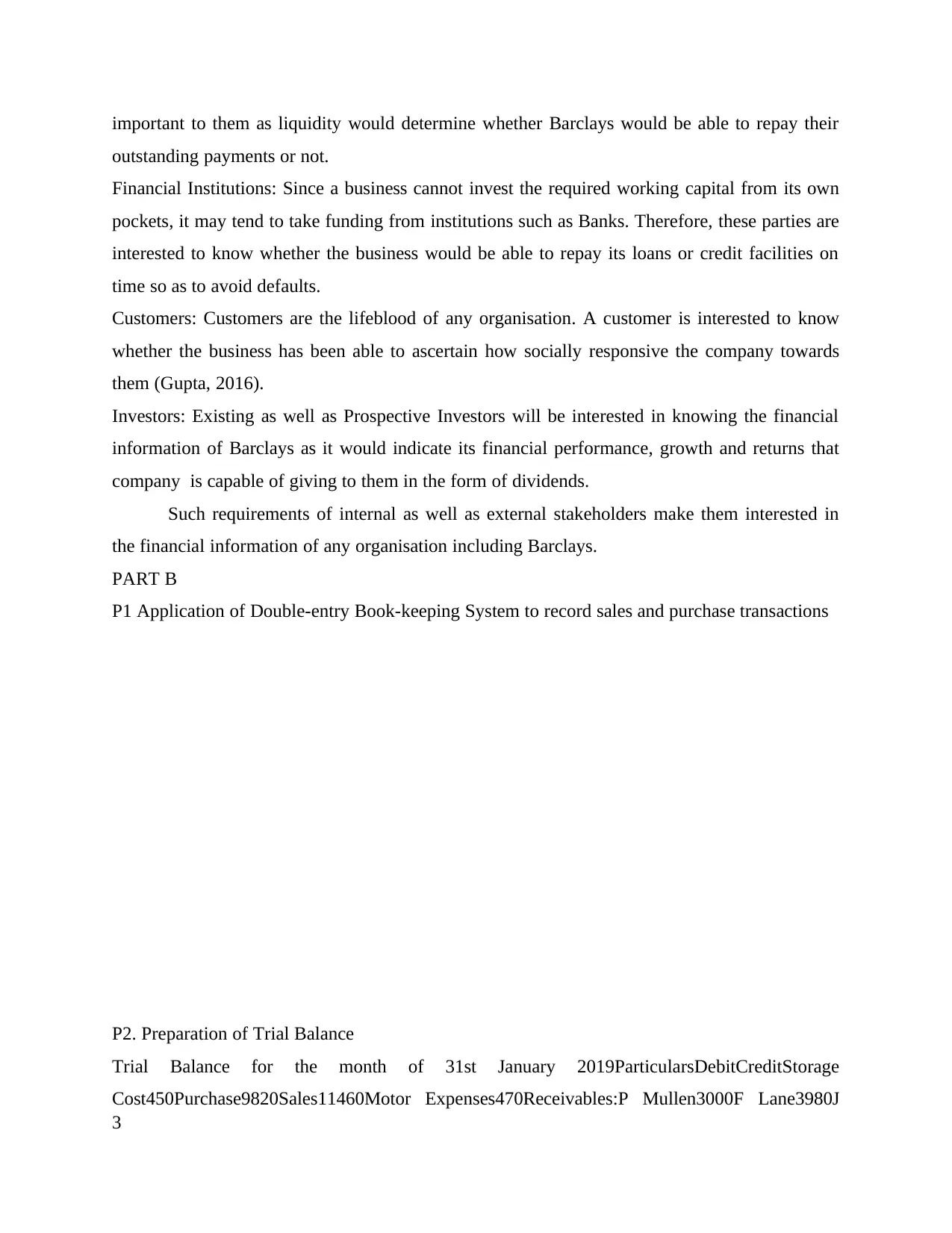
important to them as liquidity would determine whether Barclays would be able to repay their
outstanding payments or not.
Financial Institutions: Since a business cannot invest the required working capital from its own
pockets, it may tend to take funding from institutions such as Banks. Therefore, these parties are
interested to know whether the business would be able to repay its loans or credit facilities on
time so as to avoid defaults.
Customers: Customers are the lifeblood of any organisation. A customer is interested to know
whether the business has been able to ascertain how socially responsive the company towards
them (Gupta, 2016).
Investors: Existing as well as Prospective Investors will be interested in knowing the financial
information of Barclays as it would indicate its financial performance, growth and returns that
company is capable of giving to them in the form of dividends.
Such requirements of internal as well as external stakeholders make them interested in
the financial information of any organisation including Barclays.
PART B
P1 Application of Double-entry Book-keeping System to record sales and purchase transactions
P2. Preparation of Trial Balance
Trial Balance for the month of 31st January 2019ParticularsDebitCreditStorage
Cost450Purchase9820Sales11460Motor Expenses470Receivables:P Mullen3000F Lane3980J
3
outstanding payments or not.
Financial Institutions: Since a business cannot invest the required working capital from its own
pockets, it may tend to take funding from institutions such as Banks. Therefore, these parties are
interested to know whether the business would be able to repay its loans or credit facilities on
time so as to avoid defaults.
Customers: Customers are the lifeblood of any organisation. A customer is interested to know
whether the business has been able to ascertain how socially responsive the company towards
them (Gupta, 2016).
Investors: Existing as well as Prospective Investors will be interested in knowing the financial
information of Barclays as it would indicate its financial performance, growth and returns that
company is capable of giving to them in the form of dividends.
Such requirements of internal as well as external stakeholders make them interested in
the financial information of any organisation including Barclays.
PART B
P1 Application of Double-entry Book-keeping System to record sales and purchase transactions
P2. Preparation of Trial Balance
Trial Balance for the month of 31st January 2019ParticularsDebitCreditStorage
Cost450Purchase9820Sales11460Motor Expenses470Receivables:P Mullen3000F Lane3980J
3
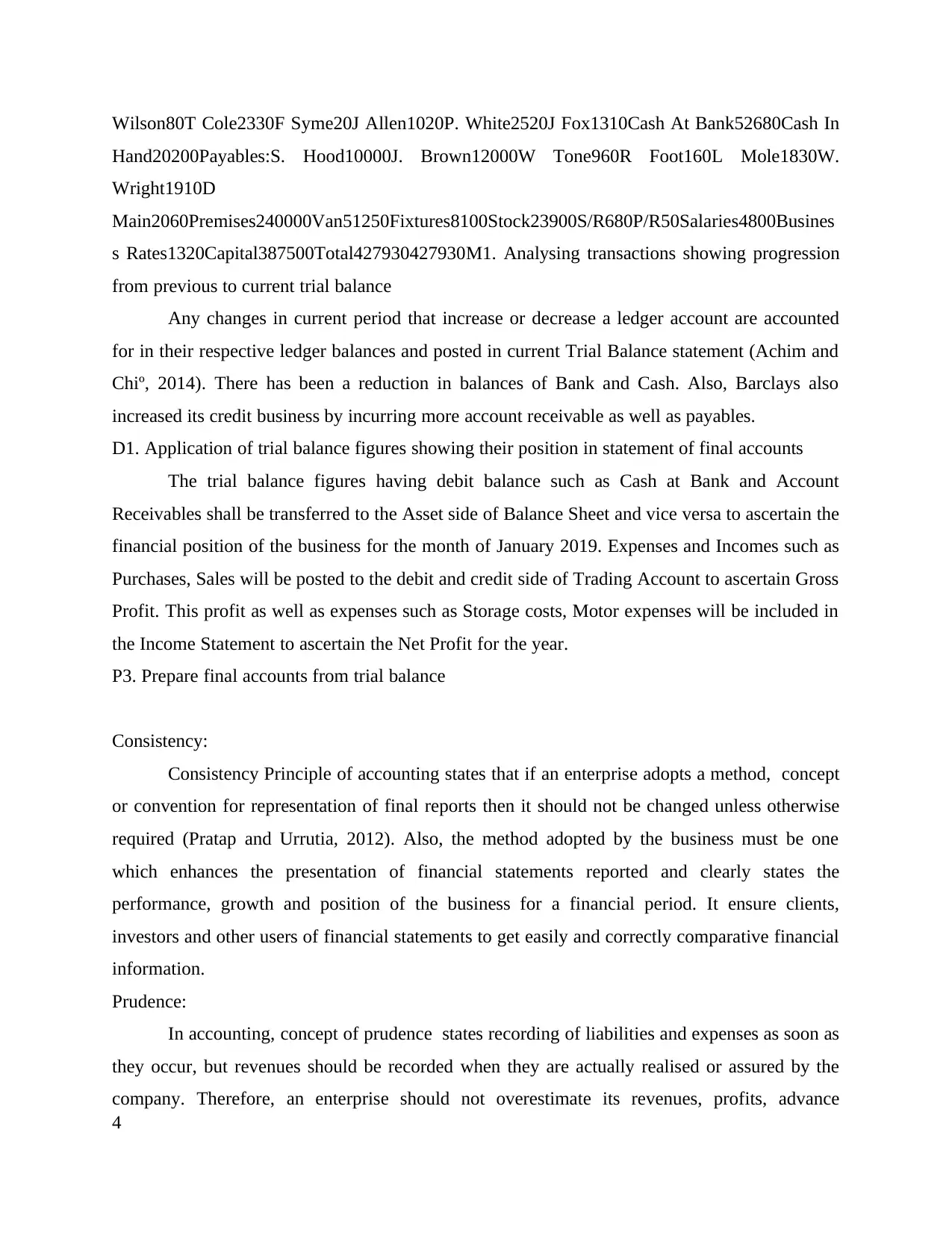
Wilson80T Cole2330F Syme20J Allen1020P. White2520J Fox1310Cash At Bank52680Cash In
Hand20200Payables:S. Hood10000J. Brown12000W Tone960R Foot160L Mole1830W.
Wright1910D
Main2060Premises240000Van51250Fixtures8100Stock23900S/R680P/R50Salaries4800Busines
s Rates1320Capital387500Total427930427930M1. Analysing transactions showing progression
from previous to current trial balance
Any changes in current period that increase or decrease a ledger account are accounted
for in their respective ledger balances and posted in current Trial Balance statement (Achim and
Chiº, 2014). There has been a reduction in balances of Bank and Cash. Also, Barclays also
increased its credit business by incurring more account receivable as well as payables.
D1. Application of trial balance figures showing their position in statement of final accounts
The trial balance figures having debit balance such as Cash at Bank and Account
Receivables shall be transferred to the Asset side of Balance Sheet and vice versa to ascertain the
financial position of the business for the month of January 2019. Expenses and Incomes such as
Purchases, Sales will be posted to the debit and credit side of Trading Account to ascertain Gross
Profit. This profit as well as expenses such as Storage costs, Motor expenses will be included in
the Income Statement to ascertain the Net Profit for the year.
P3. Prepare final accounts from trial balance
Consistency:
Consistency Principle of accounting states that if an enterprise adopts a method, concept
or convention for representation of final reports then it should not be changed unless otherwise
required (Pratap and Urrutia, 2012). Also, the method adopted by the business must be one
which enhances the presentation of financial statements reported and clearly states the
performance, growth and position of the business for a financial period. It ensure clients,
investors and other users of financial statements to get easily and correctly comparative financial
information.
Prudence:
In accounting, concept of prudence states recording of liabilities and expenses as soon as
they occur, but revenues should be recorded when they are actually realised or assured by the
company. Therefore, an enterprise should not overestimate its revenues, profits, advance
4
Hand20200Payables:S. Hood10000J. Brown12000W Tone960R Foot160L Mole1830W.
Wright1910D
Main2060Premises240000Van51250Fixtures8100Stock23900S/R680P/R50Salaries4800Busines
s Rates1320Capital387500Total427930427930M1. Analysing transactions showing progression
from previous to current trial balance
Any changes in current period that increase or decrease a ledger account are accounted
for in their respective ledger balances and posted in current Trial Balance statement (Achim and
Chiº, 2014). There has been a reduction in balances of Bank and Cash. Also, Barclays also
increased its credit business by incurring more account receivable as well as payables.
D1. Application of trial balance figures showing their position in statement of final accounts
The trial balance figures having debit balance such as Cash at Bank and Account
Receivables shall be transferred to the Asset side of Balance Sheet and vice versa to ascertain the
financial position of the business for the month of January 2019. Expenses and Incomes such as
Purchases, Sales will be posted to the debit and credit side of Trading Account to ascertain Gross
Profit. This profit as well as expenses such as Storage costs, Motor expenses will be included in
the Income Statement to ascertain the Net Profit for the year.
P3. Prepare final accounts from trial balance
Consistency:
Consistency Principle of accounting states that if an enterprise adopts a method, concept
or convention for representation of final reports then it should not be changed unless otherwise
required (Pratap and Urrutia, 2012). Also, the method adopted by the business must be one
which enhances the presentation of financial statements reported and clearly states the
performance, growth and position of the business for a financial period. It ensure clients,
investors and other users of financial statements to get easily and correctly comparative financial
information.
Prudence:
In accounting, concept of prudence states recording of liabilities and expenses as soon as
they occur, but revenues should be recorded when they are actually realised or assured by the
company. Therefore, an enterprise should not overestimate its revenues, profits, advance
4
⊘ This is a preview!⊘
Do you want full access?
Subscribe today to unlock all pages.

Trusted by 1+ million students worldwide
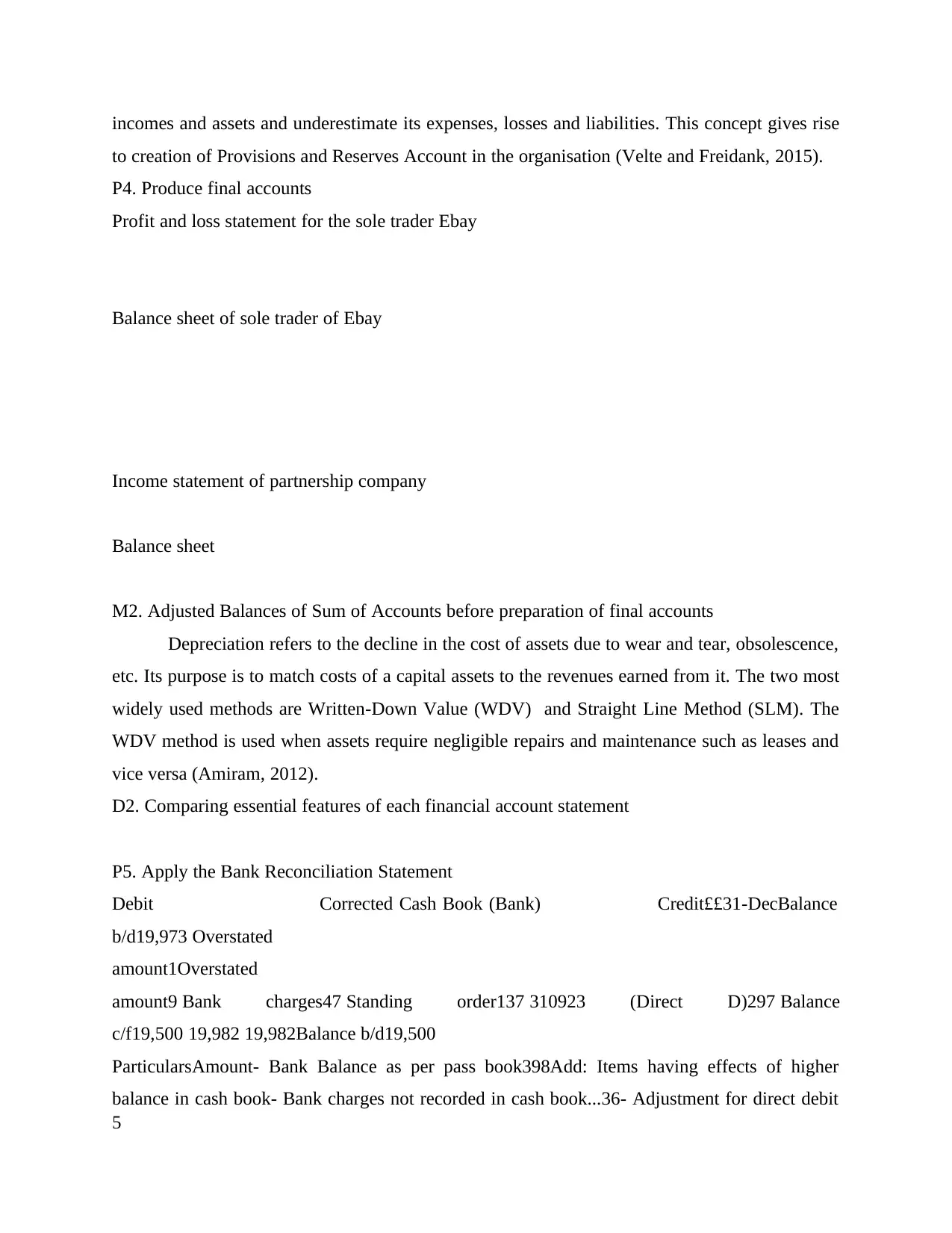
incomes and assets and underestimate its expenses, losses and liabilities. This concept gives rise
to creation of Provisions and Reserves Account in the organisation (Velte and Freidank, 2015).
P4. Produce final accounts
Profit and loss statement for the sole trader Ebay
Balance sheet of sole trader of Ebay
Income statement of partnership company
Balance sheet
M2. Adjusted Balances of Sum of Accounts before preparation of final accounts
Depreciation refers to the decline in the cost of assets due to wear and tear, obsolescence,
etc. Its purpose is to match costs of a capital assets to the revenues earned from it. The two most
widely used methods are Written-Down Value (WDV) and Straight Line Method (SLM). The
WDV method is used when assets require negligible repairs and maintenance such as leases and
vice versa (Amiram, 2012).
D2. Comparing essential features of each financial account statement
P5. Apply the Bank Reconciliation Statement
Debit Corrected Cash Book (Bank) Credit££31-DecBalance
b/d19,973 Overstated
amount1Overstated
amount9 Bank charges47 Standing order137 310923 (Direct D)297 Balance
c/f19,500 19,982 19,982Balance b/d19,500
ParticularsAmount- Bank Balance as per pass book398Add: Items having effects of higher
balance in cash book- Bank charges not recorded in cash book...36- Adjustment for direct debit
5
to creation of Provisions and Reserves Account in the organisation (Velte and Freidank, 2015).
P4. Produce final accounts
Profit and loss statement for the sole trader Ebay
Balance sheet of sole trader of Ebay
Income statement of partnership company
Balance sheet
M2. Adjusted Balances of Sum of Accounts before preparation of final accounts
Depreciation refers to the decline in the cost of assets due to wear and tear, obsolescence,
etc. Its purpose is to match costs of a capital assets to the revenues earned from it. The two most
widely used methods are Written-Down Value (WDV) and Straight Line Method (SLM). The
WDV method is used when assets require negligible repairs and maintenance such as leases and
vice versa (Amiram, 2012).
D2. Comparing essential features of each financial account statement
P5. Apply the Bank Reconciliation Statement
Debit Corrected Cash Book (Bank) Credit££31-DecBalance
b/d19,973 Overstated
amount1Overstated
amount9 Bank charges47 Standing order137 310923 (Direct D)297 Balance
c/f19,500 19,982 19,982Balance b/d19,500
ParticularsAmount- Bank Balance as per pass book398Add: Items having effects of higher
balance in cash book- Bank charges not recorded in cash book...36- Adjustment for direct debit
5
Paraphrase This Document
Need a fresh take? Get an instant paraphrase of this document with our AI Paraphraser
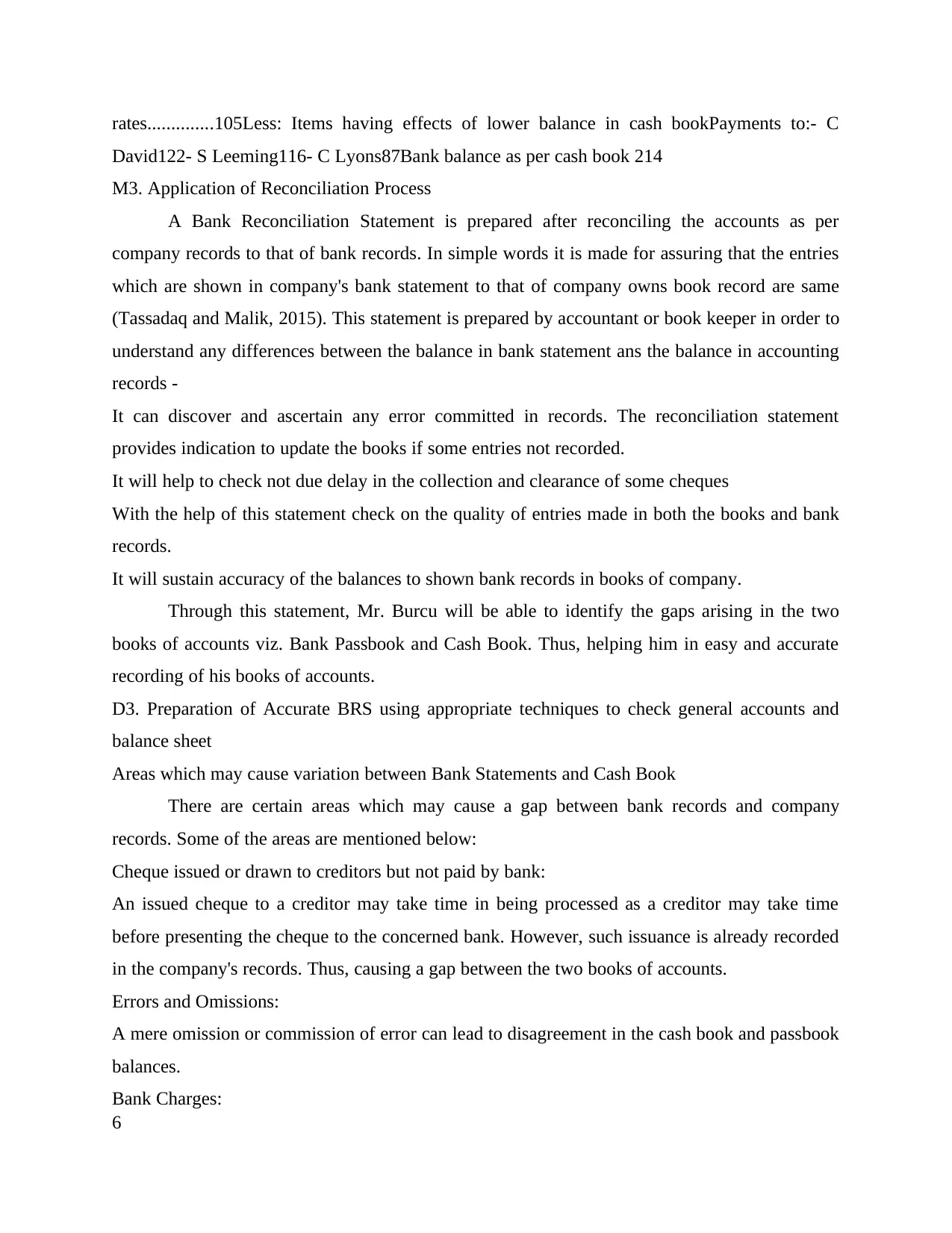
rates..............105Less: Items having effects of lower balance in cash bookPayments to:- C
David122- S Leeming116- C Lyons87Bank balance as per cash book 214
M3. Application of Reconciliation Process
A Bank Reconciliation Statement is prepared after reconciling the accounts as per
company records to that of bank records. In simple words it is made for assuring that the entries
which are shown in company's bank statement to that of company owns book record are same
(Tassadaq and Malik, 2015). This statement is prepared by accountant or book keeper in order to
understand any differences between the balance in bank statement ans the balance in accounting
records -
It can discover and ascertain any error committed in records. The reconciliation statement
provides indication to update the books if some entries not recorded.
It will help to check not due delay in the collection and clearance of some cheques
With the help of this statement check on the quality of entries made in both the books and bank
records.
It will sustain accuracy of the balances to shown bank records in books of company.
Through this statement, Mr. Burcu will be able to identify the gaps arising in the two
books of accounts viz. Bank Passbook and Cash Book. Thus, helping him in easy and accurate
recording of his books of accounts.
D3. Preparation of Accurate BRS using appropriate techniques to check general accounts and
balance sheet
Areas which may cause variation between Bank Statements and Cash Book
There are certain areas which may cause a gap between bank records and company
records. Some of the areas are mentioned below:
Cheque issued or drawn to creditors but not paid by bank:
An issued cheque to a creditor may take time in being processed as a creditor may take time
before presenting the cheque to the concerned bank. However, such issuance is already recorded
in the company's records. Thus, causing a gap between the two books of accounts.
Errors and Omissions:
A mere omission or commission of error can lead to disagreement in the cash book and passbook
balances.
Bank Charges:
6
David122- S Leeming116- C Lyons87Bank balance as per cash book 214
M3. Application of Reconciliation Process
A Bank Reconciliation Statement is prepared after reconciling the accounts as per
company records to that of bank records. In simple words it is made for assuring that the entries
which are shown in company's bank statement to that of company owns book record are same
(Tassadaq and Malik, 2015). This statement is prepared by accountant or book keeper in order to
understand any differences between the balance in bank statement ans the balance in accounting
records -
It can discover and ascertain any error committed in records. The reconciliation statement
provides indication to update the books if some entries not recorded.
It will help to check not due delay in the collection and clearance of some cheques
With the help of this statement check on the quality of entries made in both the books and bank
records.
It will sustain accuracy of the balances to shown bank records in books of company.
Through this statement, Mr. Burcu will be able to identify the gaps arising in the two
books of accounts viz. Bank Passbook and Cash Book. Thus, helping him in easy and accurate
recording of his books of accounts.
D3. Preparation of Accurate BRS using appropriate techniques to check general accounts and
balance sheet
Areas which may cause variation between Bank Statements and Cash Book
There are certain areas which may cause a gap between bank records and company
records. Some of the areas are mentioned below:
Cheque issued or drawn to creditors but not paid by bank:
An issued cheque to a creditor may take time in being processed as a creditor may take time
before presenting the cheque to the concerned bank. However, such issuance is already recorded
in the company's records. Thus, causing a gap between the two books of accounts.
Errors and Omissions:
A mere omission or commission of error can lead to disagreement in the cash book and passbook
balances.
Bank Charges:
6
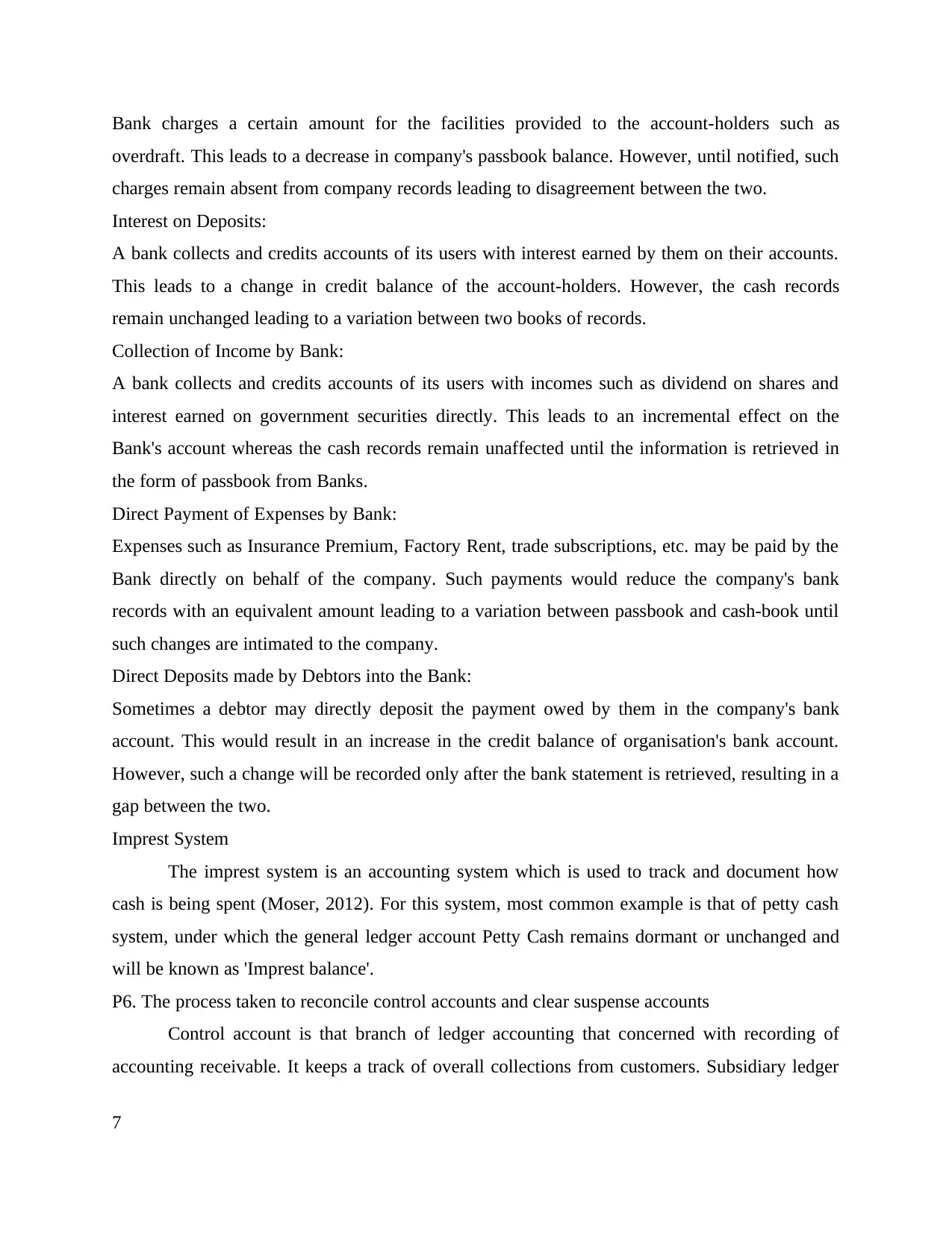
Bank charges a certain amount for the facilities provided to the account-holders such as
overdraft. This leads to a decrease in company's passbook balance. However, until notified, such
charges remain absent from company records leading to disagreement between the two.
Interest on Deposits:
A bank collects and credits accounts of its users with interest earned by them on their accounts.
This leads to a change in credit balance of the account-holders. However, the cash records
remain unchanged leading to a variation between two books of records.
Collection of Income by Bank:
A bank collects and credits accounts of its users with incomes such as dividend on shares and
interest earned on government securities directly. This leads to an incremental effect on the
Bank's account whereas the cash records remain unaffected until the information is retrieved in
the form of passbook from Banks.
Direct Payment of Expenses by Bank:
Expenses such as Insurance Premium, Factory Rent, trade subscriptions, etc. may be paid by the
Bank directly on behalf of the company. Such payments would reduce the company's bank
records with an equivalent amount leading to a variation between passbook and cash-book until
such changes are intimated to the company.
Direct Deposits made by Debtors into the Bank:
Sometimes a debtor may directly deposit the payment owed by them in the company's bank
account. This would result in an increase in the credit balance of organisation's bank account.
However, such a change will be recorded only after the bank statement is retrieved, resulting in a
gap between the two.
Imprest System
The imprest system is an accounting system which is used to track and document how
cash is being spent (Moser, 2012). For this system, most common example is that of petty cash
system, under which the general ledger account Petty Cash remains dormant or unchanged and
will be known as 'Imprest balance'.
P6. The process taken to reconcile control accounts and clear suspense accounts
Control account is that branch of ledger accounting that concerned with recording of
accounting receivable. It keeps a track of overall collections from customers. Subsidiary ledger
7
overdraft. This leads to a decrease in company's passbook balance. However, until notified, such
charges remain absent from company records leading to disagreement between the two.
Interest on Deposits:
A bank collects and credits accounts of its users with interest earned by them on their accounts.
This leads to a change in credit balance of the account-holders. However, the cash records
remain unchanged leading to a variation between two books of records.
Collection of Income by Bank:
A bank collects and credits accounts of its users with incomes such as dividend on shares and
interest earned on government securities directly. This leads to an incremental effect on the
Bank's account whereas the cash records remain unaffected until the information is retrieved in
the form of passbook from Banks.
Direct Payment of Expenses by Bank:
Expenses such as Insurance Premium, Factory Rent, trade subscriptions, etc. may be paid by the
Bank directly on behalf of the company. Such payments would reduce the company's bank
records with an equivalent amount leading to a variation between passbook and cash-book until
such changes are intimated to the company.
Direct Deposits made by Debtors into the Bank:
Sometimes a debtor may directly deposit the payment owed by them in the company's bank
account. This would result in an increase in the credit balance of organisation's bank account.
However, such a change will be recorded only after the bank statement is retrieved, resulting in a
gap between the two.
Imprest System
The imprest system is an accounting system which is used to track and document how
cash is being spent (Moser, 2012). For this system, most common example is that of petty cash
system, under which the general ledger account Petty Cash remains dormant or unchanged and
will be known as 'Imprest balance'.
P6. The process taken to reconcile control accounts and clear suspense accounts
Control account is that branch of ledger accounting that concerned with recording of
accounting receivable. It keeps a track of overall collections from customers. Subsidiary ledger
7
⊘ This is a preview!⊘
Do you want full access?
Subscribe today to unlock all pages.

Trusted by 1+ million students worldwide
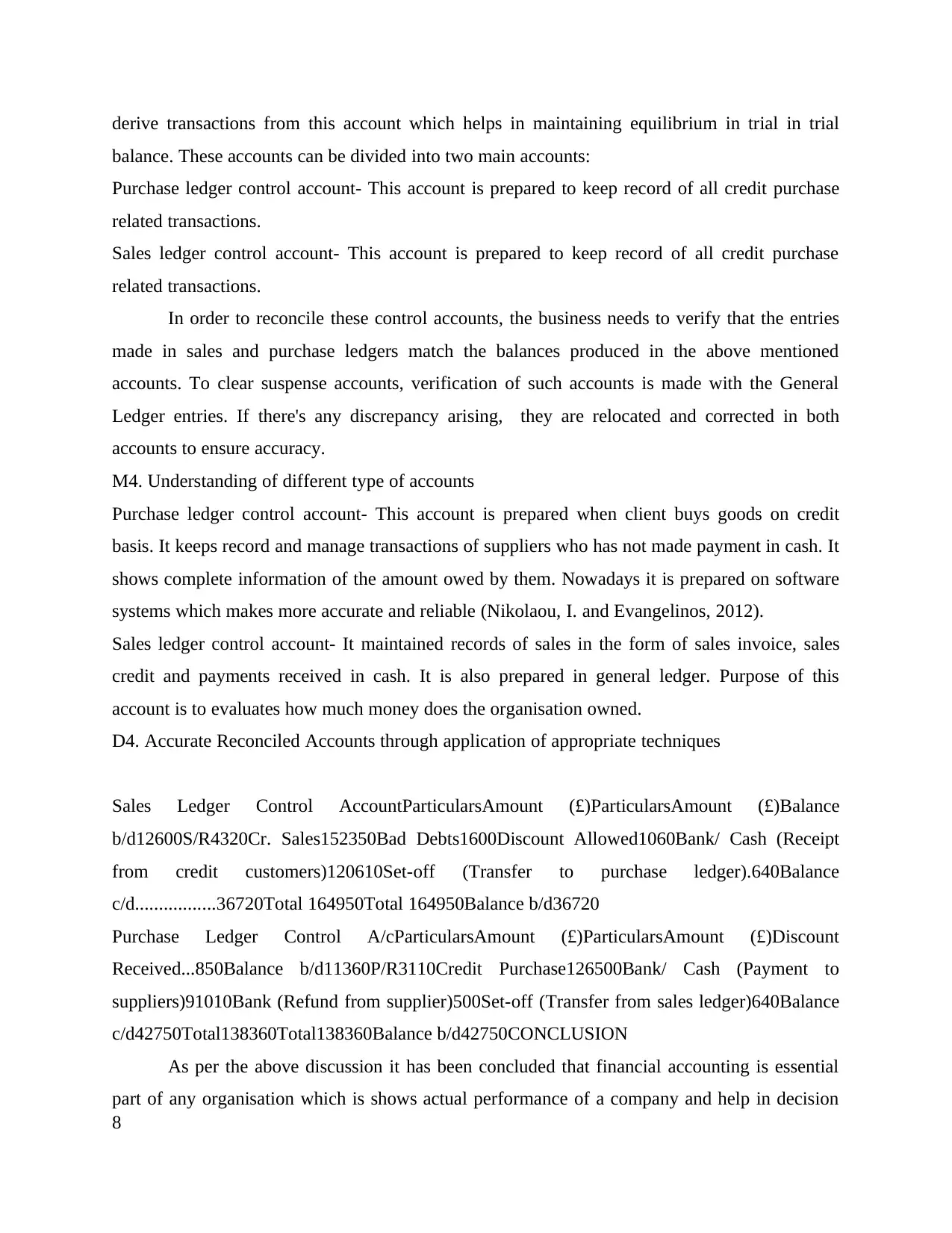
derive transactions from this account which helps in maintaining equilibrium in trial in trial
balance. These accounts can be divided into two main accounts:
Purchase ledger control account- This account is prepared to keep record of all credit purchase
related transactions.
Sales ledger control account- This account is prepared to keep record of all credit purchase
related transactions.
In order to reconcile these control accounts, the business needs to verify that the entries
made in sales and purchase ledgers match the balances produced in the above mentioned
accounts. To clear suspense accounts, verification of such accounts is made with the General
Ledger entries. If there's any discrepancy arising, they are relocated and corrected in both
accounts to ensure accuracy.
M4. Understanding of different type of accounts
Purchase ledger control account- This account is prepared when client buys goods on credit
basis. It keeps record and manage transactions of suppliers who has not made payment in cash. It
shows complete information of the amount owed by them. Nowadays it is prepared on software
systems which makes more accurate and reliable (Nikolaou, I. and Evangelinos, 2012).
Sales ledger control account- It maintained records of sales in the form of sales invoice, sales
credit and payments received in cash. It is also prepared in general ledger. Purpose of this
account is to evaluates how much money does the organisation owned.
D4. Accurate Reconciled Accounts through application of appropriate techniques
Sales Ledger Control AccountParticularsAmount (£)ParticularsAmount (£)Balance
b/d12600S/R4320Cr. Sales152350Bad Debts1600Discount Allowed1060Bank/ Cash (Receipt
from credit customers)120610Set-off (Transfer to purchase ledger).640Balance
c/d.................36720Total 164950Total 164950Balance b/d36720
Purchase Ledger Control A/cParticularsAmount (£)ParticularsAmount (£)Discount
Received...850Balance b/d11360P/R3110Credit Purchase126500Bank/ Cash (Payment to
suppliers)91010Bank (Refund from supplier)500Set-off (Transfer from sales ledger)640Balance
c/d42750Total138360Total138360Balance b/d42750CONCLUSION
As per the above discussion it has been concluded that financial accounting is essential
part of any organisation which is shows actual performance of a company and help in decision
8
balance. These accounts can be divided into two main accounts:
Purchase ledger control account- This account is prepared to keep record of all credit purchase
related transactions.
Sales ledger control account- This account is prepared to keep record of all credit purchase
related transactions.
In order to reconcile these control accounts, the business needs to verify that the entries
made in sales and purchase ledgers match the balances produced in the above mentioned
accounts. To clear suspense accounts, verification of such accounts is made with the General
Ledger entries. If there's any discrepancy arising, they are relocated and corrected in both
accounts to ensure accuracy.
M4. Understanding of different type of accounts
Purchase ledger control account- This account is prepared when client buys goods on credit
basis. It keeps record and manage transactions of suppliers who has not made payment in cash. It
shows complete information of the amount owed by them. Nowadays it is prepared on software
systems which makes more accurate and reliable (Nikolaou, I. and Evangelinos, 2012).
Sales ledger control account- It maintained records of sales in the form of sales invoice, sales
credit and payments received in cash. It is also prepared in general ledger. Purpose of this
account is to evaluates how much money does the organisation owned.
D4. Accurate Reconciled Accounts through application of appropriate techniques
Sales Ledger Control AccountParticularsAmount (£)ParticularsAmount (£)Balance
b/d12600S/R4320Cr. Sales152350Bad Debts1600Discount Allowed1060Bank/ Cash (Receipt
from credit customers)120610Set-off (Transfer to purchase ledger).640Balance
c/d.................36720Total 164950Total 164950Balance b/d36720
Purchase Ledger Control A/cParticularsAmount (£)ParticularsAmount (£)Discount
Received...850Balance b/d11360P/R3110Credit Purchase126500Bank/ Cash (Payment to
suppliers)91010Bank (Refund from supplier)500Set-off (Transfer from sales ledger)640Balance
c/d42750Total138360Total138360Balance b/d42750CONCLUSION
As per the above discussion it has been concluded that financial accounting is essential
part of any organisation which is shows actual performance of a company and help in decision
8
Paraphrase This Document
Need a fresh take? Get an instant paraphrase of this document with our AI Paraphraser

making process. With the help of accounting prepare different types of financial statement which
is presented in front of internal and external stakeholders. There is produce balance, ledger
accounts and trial balance to show position of a company and reconcile of bank statement.
REFERENCES
Books and Journals
Iatridis, G. and Dimitras, A. I., 2013. Financial crisis and accounting quality: evidence from five
European countries. Advances in Accounting, 29(1), pp.154-160.
Edwards, A., Schwab, C. and Shevlin, T., 2015. Financial constraints and cash tax savings. The
Accounting Review. 91(3). pp.859-881.
Kim, J. B. and Zhang, L., 2016. Accounting conservatism and stock price crash risk: Firm-level
evidence. Contemporary Accounting Research. 33(1). pp.412-441.
Abernathy, J. L. And et.al, 2014. The association between characteristics of audit committee
accounting experts, audit committee chairs, and financial reporting timeliness. Advances in
Accounting. 30(2). pp.283-297.
Gupta, A., 2016. Financial Accounting for Management. Pearson Education India.
Achim, A. M. and Chiº, A. O., 2014. FINANCIAL ACCOUNTING QUALITY AND ITS
DEFINING CHARACTERISTICS. SEA: Practical Application of Science. 2(3).
Pratap, S. and Urrutia, C., 2012. Financial frictions and total factor productivity: Accounting for
the real effects of financial crises. Review of Economic Dynamics. 15(3). pp.336-358.
Velte, P. and Freidank, C. C., 2015. The link between in-and external rotation of the auditor and
the quality of financial accounting and external audit. European journal of law and economics.
40(2). pp.225-246.
Amiram, D., 2012. Financial information globalization and foreign investment decisions. Journal
of International Accounting Research. 11(2). pp.57-81.
Tassadaq, F. and Malik, Q. A., 2015. Creative Accounting & Financial Reporting: Model
Development & Empirical Testing. International Journal of Economics and Financial Issues.
5(2). pp.544-551.
Moser, D. V., 2012. Is accounting research stagnant?. Accounting Horizons. 26(4). pp.845-850.
Nikolaou, I. and Evangelinos, K., 2012. Financial and non-financial environmental information:
significant factors for corporate environmental performance measuring. International Journal of
Managerial and Financial Accounting. 4(1). pp.61-77.
9
is presented in front of internal and external stakeholders. There is produce balance, ledger
accounts and trial balance to show position of a company and reconcile of bank statement.
REFERENCES
Books and Journals
Iatridis, G. and Dimitras, A. I., 2013. Financial crisis and accounting quality: evidence from five
European countries. Advances in Accounting, 29(1), pp.154-160.
Edwards, A., Schwab, C. and Shevlin, T., 2015. Financial constraints and cash tax savings. The
Accounting Review. 91(3). pp.859-881.
Kim, J. B. and Zhang, L., 2016. Accounting conservatism and stock price crash risk: Firm-level
evidence. Contemporary Accounting Research. 33(1). pp.412-441.
Abernathy, J. L. And et.al, 2014. The association between characteristics of audit committee
accounting experts, audit committee chairs, and financial reporting timeliness. Advances in
Accounting. 30(2). pp.283-297.
Gupta, A., 2016. Financial Accounting for Management. Pearson Education India.
Achim, A. M. and Chiº, A. O., 2014. FINANCIAL ACCOUNTING QUALITY AND ITS
DEFINING CHARACTERISTICS. SEA: Practical Application of Science. 2(3).
Pratap, S. and Urrutia, C., 2012. Financial frictions and total factor productivity: Accounting for
the real effects of financial crises. Review of Economic Dynamics. 15(3). pp.336-358.
Velte, P. and Freidank, C. C., 2015. The link between in-and external rotation of the auditor and
the quality of financial accounting and external audit. European journal of law and economics.
40(2). pp.225-246.
Amiram, D., 2012. Financial information globalization and foreign investment decisions. Journal
of International Accounting Research. 11(2). pp.57-81.
Tassadaq, F. and Malik, Q. A., 2015. Creative Accounting & Financial Reporting: Model
Development & Empirical Testing. International Journal of Economics and Financial Issues.
5(2). pp.544-551.
Moser, D. V., 2012. Is accounting research stagnant?. Accounting Horizons. 26(4). pp.845-850.
Nikolaou, I. and Evangelinos, K., 2012. Financial and non-financial environmental information:
significant factors for corporate environmental performance measuring. International Journal of
Managerial and Financial Accounting. 4(1). pp.61-77.
9

10
⊘ This is a preview!⊘
Do you want full access?
Subscribe today to unlock all pages.

Trusted by 1+ million students worldwide
1 out of 12
Related Documents
Your All-in-One AI-Powered Toolkit for Academic Success.
+13062052269
info@desklib.com
Available 24*7 on WhatsApp / Email
![[object Object]](/_next/static/media/star-bottom.7253800d.svg)
Unlock your academic potential
Copyright © 2020–2025 A2Z Services. All Rights Reserved. Developed and managed by ZUCOL.





